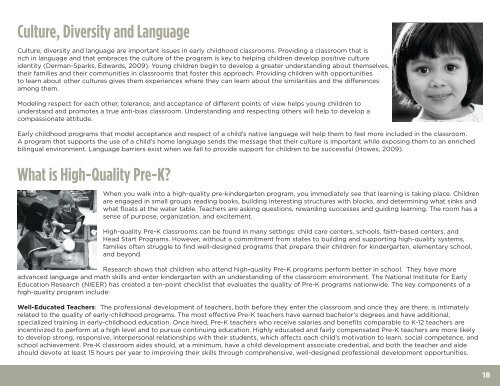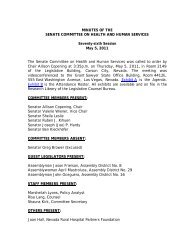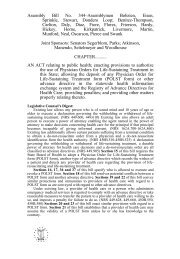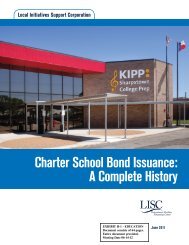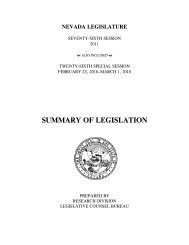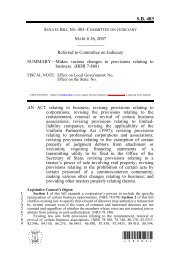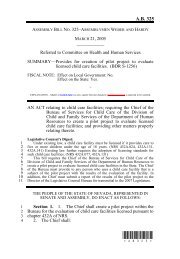Nevada Pre-Kindergarten Standards
Nevada Pre-Kindergarten Standards
Nevada Pre-Kindergarten Standards
You also want an ePaper? Increase the reach of your titles
YUMPU automatically turns print PDFs into web optimized ePapers that Google loves.
Culture, Diversity and Language<br />
Culture, diversity and language are important issues in early childhood classrooms. Providing a classroom that is<br />
rich in language and that embraces the culture of the program is key to helping children develop positive culture<br />
identity (Derman-Sparks, Edwards, 2009). Young children begin to develop a greater understanding about themselves,<br />
their families and their communities in classrooms that foster this approach. Providing children with opportunities<br />
to learn about other cultures gives them experiences where they can learn about the similarities and the differences<br />
among them.<br />
Modeling respect for each other, tolerance, and acceptance of different points of view helps young children to<br />
understand and promotes a true anti-bias classroom. Understanding and respecting others will help to develop a<br />
compassionate attitude.<br />
Early childhood programs that model acceptance and respect of a child’s native language will help them to feel more included in the classroom.<br />
A program that supports the use of a child’s home language sends the message that their culture is important while exposing them to an enriched<br />
bilingual environment. Language barriers exist when we fail to provide support for children to be successful (Howes, 2009).<br />
What is High-Quality <strong>Pre</strong>-K?<br />
When you walk into a high-quality pre-kindergarten program, you immediately see that learning is taking place. Children<br />
are engaged in small groups reading books, building interesting structures with blocks, and determining what sinks and<br />
what floats at the water table. Teachers are asking questions, rewarding successes and guiding learning. The room has a<br />
sense of purpose, organization, and excitement.<br />
High-quality <strong>Pre</strong>-K classrooms can be found in many settings: child care centers, schools, faith-based centers, and<br />
Head Start Programs. However, without a commitment from states to building and supporting high-quality systems,<br />
families often struggle to find well-designed programs that prepare their children for kindergarten, elementary school,<br />
and beyond.<br />
Research shows that children who attend high-quality <strong>Pre</strong>-K programs perform better in school. They have more<br />
advanced language and math skills and enter kindergarten with an understanding of the classroom environment. The National Institute for Early<br />
Education Research (NIEER) has created a ten-point checklist that evaluates the quality of <strong>Pre</strong>-K programs nationwide. The key components of a<br />
high-quality program include:<br />
Well-Educated Teachers: The professional development of teachers, both before they enter the classroom and once they are there, is intimately<br />
related to the quality of early-childhood programs. The most effective <strong>Pre</strong>-K teachers have earned bachelor’s degrees and have additional,<br />
specialized training in early-childhood education. Once hired, <strong>Pre</strong>-K teachers who receive salaries and benefits comparable to K-12 teachers are<br />
incentivized to perform at a high level and to pursue continuing education. Highly educated and fairly compensated <strong>Pre</strong>-K teachers are more likely<br />
to develop strong, responsive, interpersonal relationships with their students, which affects each child’s motivation to learn, social competence, and<br />
school achievement. <strong>Pre</strong>-K classroom aides should, at a minimum, have a child development associate credential, and both the teacher and aide<br />
should devote at least 15 hours per year to improving their skills through comprehensive, well-designed professional development opportunities.<br />
18


